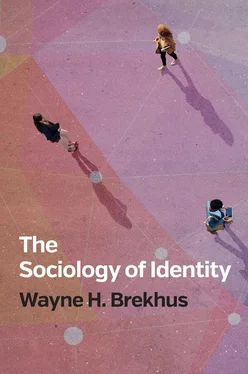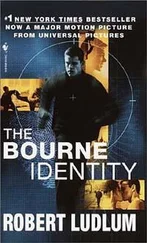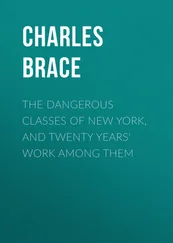Eviatar Zerubavel’s passion for thinking about big topics in analytically creative ways continues to inspire my own thinking. I am grateful for his ongoing enthusiasm and intellectual guidance. I thank Lorenzo Sabetta for the many stimulating conversations we have had on issues related to identity and the unmarked. He came from Italy to study with me for a year, as a postdoctoral fellow, and I am indebted to him for our friendship. I also thank Jay Gubrium for our many interesting discussions about identity and for his encouragement as a colleague. I thank my wife Rachel, who has helped me think through ideas, has read through and commented on drafts and revisions, and has been a tremendous source of intellectual and moral support.
Identity is central to human meaning, social life, and social interaction. We often think of identity as a personal, individual matter, but identity is intensely social both in its formation and in its implications. Identity has important consequences for how we organize our lives, wield social power, include and exclude others from our closest social networks, and produce and reproduce privilege and marginality. We do identity for a variety of reasons, some tacit, some strategic. We express identity in both individual and collective forms. This book examines the sociology of identity, emphasizing three themes: authenticity, multidimensionality, and mobility. These themes are intricately tied to power, privilege, stigma, marginality, and the politics of inclusion and exclusion. They also directly relate to one another. We strive toward authenticity to ourselves and to our categories of belonging in multidimensional, fluid, and mobile ways.
Authenticity refers to the ways in which people try to authenticate personal selves or group membership. Multidimensionality refers to how people navigate multiple intersecting elements that make up their self-identity or collective identity. Mobility refers to the strategies and cultural currencies people use to navigate transitory and migratory shifts in their selves or in their collective identities across space and time. These organizing themes bring together a diverse body of research on identities to specifically highlight the important social work that identity does. The social work that identity does is both positive and negative, ranging from pride to prejudice, from altruism to bullying, from finding belonging to differentiating.
Identity is a concept directly connected to one of sociology’s central concerns: the production and reproduction of social inequalities. In consequence, the approach developed here differs from approaches in texts that regard identity as a primarily personal concern, connected to individual psychology, or that examine it largely as a matter of self-conception. Individualistic approaches often assume a general self not directly tied to sociological, cultural, and material dimensions that differentially shape different social types of selves. Psychological approaches focused on the self are important in their own right, but the romantic image of an individual looking in a mirror and wondering “Who am I?”—even when presented as a “looking-glass self” (Cooley 1964) that considers the question by internalizing society—puts before us a relatively individualistic view of identity that misses some of its dynamic social nature. The concepts of authenticity, multidimensionality, and mobility help us to see the complex social work that identity does. Related to the fundamentally social character of identity, this book examines identity in collective as well as socially shaped individual forms. To begin thinking about identity, let us consider the following examples.
In Italy, Mahmood (Alessandro Mahmoud), a 26-year-old man born in Milan to a mother from Sardinia and a father from Egypt, captured the hearts of audiences at a televised singing competition in 2019. Mahmood became an instant pop sensation, winning Italy’s San Remo music festival, and thus qualified to represent Italy at the 2019 Eurovision song contest in Tel Aviv, Israel. But the victory that allowed Mahmood to represent Italy turned out to be controversial. Italian anti-immigrant political leaders expressed anger that Mahmood was selected by the judges and that he beat out singers of “more Italian” songs. Deputy Prime Minister Matteo Salvini tweeted: “#Mahmood … meh … the most beautiful Italian song?!?”—a line that many interpreted as a challenge to the Italian identity of Mahmood and his music. In response to the controversy, a member of Salvini’s political party introduced legislation designed to limit “foreign” music played on the radio. For Mahmood’s critics, his partially Egyptian ancestry made the authenticity of his Italian identity suspect; his Egyptian heritage weighed on their perceptions of his identity. In response to these attacks on his identity, Mahmood identified himself as one hundred percent Italian. The deputy prime minister and members of his party implied that Mahmood’s multiethnic background gave him a “foreign” and diluted form of Italianness, which was less authentic that that of someone of “pure Italian descent.” Mahmood, by contrast, saw nothing in his multidimensional ethnic ancestry that diluted his authenticity or rendered him anything but one hundred percent Italian.
In California, a working-class Mexican American teenage girl puts on dark lip color and dark nail polish before she heads to high school. She prefers the dark colors popular in her las chicas social clique, a group of mostly working-class Latina girls who define themselves against the popular clique of preppie girls or “preps.” Across town, in an upper-middle-class neighborhood, her white classmate, a prep girl, is putting on the light pastel lip and nail colors favored in her social clique. The Latina girl deliberately chooses a dark lip color popular in her social network; she wants to set herself apart from the dominant preps, who are mostly white (see Bettie 2000, 2014). In doing so she shares with her “cliquemates” a subcultural style that emphasizes their marked ethnicity and their working-class status. She also chooses darker colors associated with “somberness, age, and sophistication,” colors that lack the “youth, innocence, and gaiety” associations of the pastel colors preferred in the preppie clique; such color choices coincide respectively with working- and middle-class life-stage expectations (see Bettie 2000: 14–15). The white middle-class girl who wears light pastel lipstick also wears relatively expensive clothes, in a fashionable style approved by her peers in the school’s most popular clique. In this way she performs a school-sanctioned femininity, which expresses her identity as a socially valued “good” white kid from a middle-class background, and she distinguishes herself from the more socially marked “deviant” subcultures of the school. She perceives girls who wear dark makeup as “less classy” (and lower in social class) and regards her own performance as more respectable than theirs.
In Nottingham, England, a middle-aged and middle-class man with British citizenship identifies as European and wants the United Kingdom to remain in the European Union. Across the city a working-class man of a similar age identifies as British and strongly supports Brexit—Britain’s exit from the European Union. Both men live in the United Kingdom, but one identifies as British and European and the other as British. These differences in identification correspond to significant differences in worldviews and political attitudes.
In the United States Sarah Palin, vice presidential candidate in 2008, generated controversy by stating that “the best of America is in these small towns that we get to visit, and in these wonderful pockets of what I call the real America … hard working, very patriotic, very pro-America areas of this great nation” (Silver 2008). Palin made it forcefully clear that she aligns herself with a popular conservative view that the most authentic, “real American” identity lies in the predominantly white small towns and rural areas of the American Midwest, of the American South, and of the Great Plains and Rocky Mountain states. Other politicians and cultural commentators pushed back, emphasizing a “real America” that welcomes immigrants and is multicultural or culturally cosmopolitan, diverse, and urban. A strong debate ensued over the identities of “America” and “Americans” and over who counts as “authentically American” and where. This debate rages on as Donald Trump’s nostalgic, nativist vision of “making America great again” clashes with the more anti-nostalgic, pro-immigrant, multicultural visions of American greatness touted by his critics, in a hotly divided country torn between opposing visions of its desired identity and of what counts most for a definition of authentic Americanness.
Читать дальше












